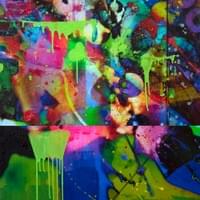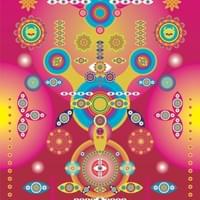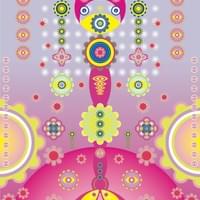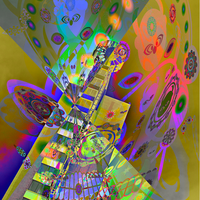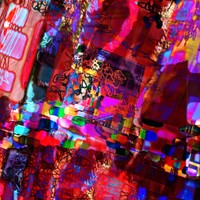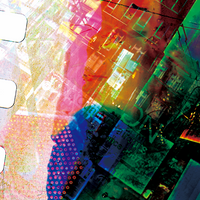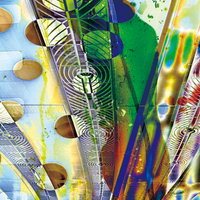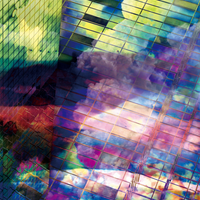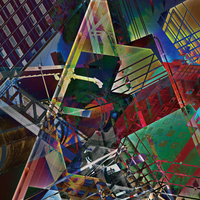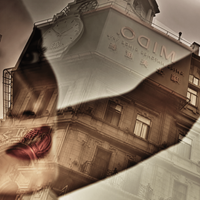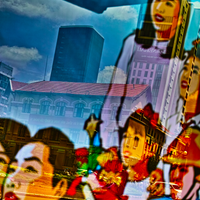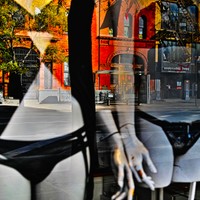
OSAMU SATO
SOLO EXHIBITION 2022
ROOTS
Photography without a camera.
Experimental abstract pictorial photographThe emulsion is gelatinous, so it is permeable to moisture, and can be inked, scratched, or punctured with a needle or knife.
The film is then digitized, and a computer is used to control and edit the film to create a photograph. It is a kind of chance operation editing, and for me, it is a pictorial work.
The resulting work is an experimental abstract pictorial photograph, and this kind of work occupies a large place in my roots.In other words, this is a painting.
Paint is splashed on an abstract photograph. The image stretched from the film is mixed with the paint in a complex way. It is difficult to control, and there is no turning back. This physical process, which in some instances can ruin the work, but the tension is the real appeal of this work.
And this ancestral work is also my roots.Download Now
You can add any link or even upload a file to this button!
ABOUT MYSELF

OSAMU SATO
JAPANESE ARTIST
Born in Kyoto, Japan in 1960. Living and working in Tokyo, Japan.
Studied photographic science and graphic design at an art university. Held the first exhibition, ‘The Alphabetical Orgasm’, a series of computer graphic arts, in 1991which was praised and covered by many domestic and overseas presses. Following the first exhibition, released several new art works regularly. Awarded a Grand Prix at the digital entertainment program by Sony Music. Expanded activities to major market and made a debut as a multi media artist from Sony. Released several music, games and video contents that were highly recognized. Among these, ‘LSD Dream Emulator’, the content for PLAY STATION, was especially praised as art masterpiece and created a new era of computer games. It is still enthusing audiences all over the world. Resumed activities as a graphic artist and photographer in recent years.
Modernism after 100 years
by Kenji Takazawa (Critic of Photography)
★Moholy-Nagy László’s prediction
In the beginning of 20th century, Moholy-Nazy Laszio left a phrase in his treatise ‘Fotografie ist Lichtgestaltung (Photograph is Manipulation of Lights)’, “We cannot define the limit of photography, everything is still new here. As long as we explore, it will lead to creative results. Of course, it is technology which will open the paths. In the future, it is not a person who is not familiar with letters, but a person who is not familiar with Photograph who will be considered an illiterate (analfabet)”. (*1) His prediction has come true. Posting photos on the SNS has become a common practice and photos are used as more eloquent tool than words. Starting from paintings and designs, he expanded his territories of artistic activity to photography and movies. At the same time, Moholy-Nagy devoted much effort to education and published books for the general public. Underlying his broad activity, was a volition to reform the definition of art itself. After nearly 90 years of Moholy-Nazy’s ‘Photography is Manipulation of Lights’, and roughly 100 years from the birth of modernism, human race had gone through many environmental changes. The biggest change among them is digital and the internet.
Sato started his carrier as an art director/graphic designer. His work used the computer, Apple Macintosh II as a start, from the early days. His design using computer was more accurate and smooth than hand written line and gave novelty to his works at that time. Furthermore, the complicated structure woven into the design was like a labyrinth and had a power to draw people into his work. The computer was used as a tool for shaping his own imagination. In addition, the computer was not a tool with a single function like pen and paint, but it has expanded the “ways to express” for Sato dramatically beyond the conventional category, from graphics to animation and further to music. And then, integration of all these categories led him to the first computer game production. That was the game “Tong-Nou” (1994), which was released not only in Japan, but also in the US under the title “Eastern Mind”. Following this, a music CD “EQUAL” was released in Europe. After the PlayStation game software “LSD” in 1998, Sato’s activity as an artist was temporary suspended. Despite this, these titles continued to spread in the internet space on their own like a wildfire. In 2017, his latest work is scheduled to be released as a vinyl from the label in Berlin and as a CD in Japan - a proof that his works are not outdated even now.
Sato’s activity up to this period do not include photography. Although he incorporated photographs as images into designs and games, it is only in recent years that photography has emerged as a way of expression. When he resumed his activity as an artist, the media he chose with music was photography. “Because I like to travel, I often took photos in cities overseas since the film camera era. But I only took them with an idea that they could be used as design material. Then switching to a digital camera made me conscious of taking photos as art. With the technology innovation, it became possible to obtain overwhelming resolution, and by processing images by RAW development, I found that it was easy to realize what was a struggle with analog. I thought I could work with photos if it was on the desktop computer and not in the photo darkroom which did not suit my taste. Furthermore, all photos, illustrations and CGs can be treated equally on a computer. I thought it could be used for creating art works”. (*2)
★The reality interpreted by brain
For Sato, ideas of his work come from his brain, but it is not from the intellectual level on the surface of consciousness, and is from an intuitive one arising from his unconsciousness deep down. Approach to such unconscious world actually works well with photography. For example, Daido Moriyama often says that he walks around in the city without thinking anything, and releases the shutter. Sato also takes photograph unintentionally in the city. Then he takes the photographs into the computer and processes their digital data. In general, image processing is an act that a creator intentionally controls the photograph, whether it is in a photo darkroom or on the computer. However, Sato’s uniqueness is to manipulate the data intuitively and unconsciously once again. Conscious image processing at this stage will be affected by a familiar composition or color sensation. Sato believes that we cannot “see things we have never seen” unless we exit from such a conscious world. For Sato, final art work using computer is the outcome of externalizing his brain, and outputting from there. Although he is in control, the computer has the potential to exceed what was expected at the time of operation. At the same time, the artist shifts from his position of “creating” to “watching”.
In addition, another layer is superimposed on Sato’s photography: film. Sato’s father and grandfather were photographers, so he was familiar with films since childhood. Sato ignites photographed film, physically stain it with ink etc., then scan it and convert it into digital data, and processes this data further by superimposing image taken with a digital camera. In another word, in this one photograph, you see layers of “history” from film to digital, and to the present when it is common for tuning data with a filtering function. For Sato, it is important that his photograph is equivalent to a wide variety of his works such as painting, graphic design, animation, music and games. This philosophy indeed is reflected in the title of this photo-book and the title of the music CD “All things must be equal”.
★With immature eyes and brain
Going back to the story of at the beginning, Moholy-Nazy found a new potential of vision in the photography. However, this does not immediately change the human vision. He said “Although photography was invented over 100 years, it was only in recent years that we recognized a formative necessity beyond its specialty. For the first time recently, our vision has matured enough to grasp these relationship”. The same can be said for digitalization, the internet, and computing. We certainly got new technology. But are we mature enough to manage them as means to perceive the world? For now, all digital photographs are doing is capturing the surface of the world, tuning it and outputting it. In the modern society, the photographs are not more than a thing that lets their brains “please” or “accept” this harsh reality. Sato reveals the present world that has turned into a huge procession mechanism as information flows constantly on the network. His work has just begun.
References
1 ‘Fotografie ist Lichtgestaltung’, Moholy-Nagy Laszlo (1928). ‘Photograph is Manipulation of Lights’, translated by Masafumi Fukagawa (2011). ‘Lanoratory of Vision’, pictorial record from ‘Moholy-Nagy Laszlo/In Motion’ exhibition (2011) 198-201.
2 An interview with Osamu Sato. (December 5, 2016).
3 ‘Maleri, Fotografie, Film’, Moholy-Nagy Laszlo (1925). ‘Painting, Photography, Flm’, translated by Isao Toshimitsu (1993).
Copyright 2015













